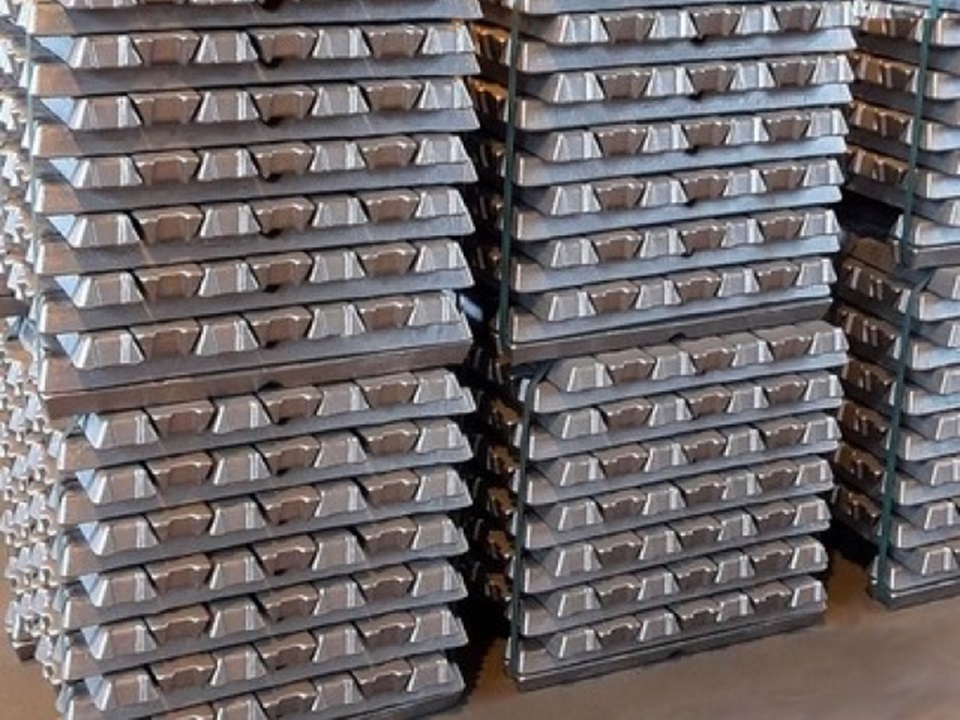We unleash your business potential by maximize the business innovation.
Send EmailAluminum Ingot, Pure Aluminum Ingot, Aluminum Light Metal, A0, A1, A3, A5, A6, A7, A8, A9, 7429-90-5
Aluminum Ingot is the raw form of aluminum and is used in various industrial applications. Aluminum is a preferred metal due to its lightweight, corrosion resistance, and workability. Below is detailed information about aluminum ingots, including technical specifications, physical and chemical properties, uses, and other details:
1. Technical Information:
-
CAS No: 7429-90-5
-
Chemical Formula: Al
-
Molecular Weight: 26.98 g/mol
-
Density: 2.7 g/cm³
-
Melting Point: 660.32°C
-
Boiling Point: 2519°C
-
Hardness: 2.75 on the Mohs scale (a relatively soft metal).
2. Physical and Chemical Properties:
Physical Properties:
-
Color: Silvery white.
-
Surface: Bright and smooth.
-
Conductivity: High electrical and thermal conductivity.
-
Lightweight: Approximately three times lighter than iron.
-
Malleability: Easily shaped and processed.
Chemical Properties:
-
Corrosion Resistance: A thin oxide layer (Al₂O₃) forms on the surface, providing protection against corrosion.
-
Reactivity: Pure aluminum oxidizes quickly in air. It reacts with acids and bases.
-
Flammability: Aluminum powder is flammable, but ingots are not.
3. Applications:
Aluminum ingots are used as raw materials in various industrial sectors. Key applications include:
a. Aluminum Alloys:
-
Used in the automotive industry to produce lightweight and durable parts.
-
Preferred in the aerospace industry for structural materials.
b. Construction and Architecture:
-
Used in the production of windows, doors, facade cladding, and roofing materials.
c. Electrical and Electronics:
-
Used in the production of electrical conductors, cables, and electronic devices.
d. Packaging Industry:
-
Used in the production of aluminum foil, cans, and beverage containers.
e. Machinery and Equipment:
-
Used in the production of machine parts, pumps, and valves.
f. Chemical Industry:
-
Used as a catalyst and reducing agent in chemical reactions.
4. Other Names:
-
English: Aluminum Ingot
-
Chemical Name: Aluminum (Al)
-
Industrial Term: Pure Aluminum Ingot
5. Common Names:
-
Aluminum: Commonly referred to as "aluminum" in everyday language.
-
Light Metal: Often called "light metal" due to its lightweight nature.
6. Why Choose Aluminum Ingots?
Aluminum ingots are preferred in many industrial applications due to the following properties:
a. Lightweight:
-
Much lighter than iron, reducing transportation and processing costs.
b. Corrosion Resistance:
-
The oxide layer on its surface provides protection against rust.
c. Workability:
-
Easily cast, shaped, and processed.
d. Recyclability:
-
100% recyclable, making it an environmentally friendly material.
e. Conductivity:
-
High electrical and thermal conductivity, making it ideal for electrical and electronic applications.
f. Aesthetic Appeal:
-
Bright and modern appearance, preferred in architectural and design applications.
Summary:
Aluminum ingots are widely used in various industrial applications due to their lightweight, corrosion resistance, and workability. They are essential in the automotive, construction, electrical, and packaging industries. China, Russia, and India are the leading producers of aluminum ingots.
🌍 International Aluminum A-Series Ingots (with Purity)
| Type (A-Series) | Purity (%) | Density (g/cm³) | Melting Range (°C) | Corrosion Resistance | Castability | Applications |
|---|---|---|---|---|---|---|
| A0 | ≥ 99.70 | ~2.70 | 650–660 | Medium | Good | General casting applications |
| A1 | ≥ 99.80 | ~2.70 | 640–650 | Good | Very good | Pressure die casting parts |
| A3 | ≥ 99.85 | ~2.68 | 630–640 | Medium | Good | Thin-walled castings |
| A5 | ≥ 99.90 | ~2.67 | 620–630 | Medium | Good | General engineering parts |
| A6 | ≥ 99.90 | ~2.66 | 615–625 | Good | Very good | Electrical conductivity castings |
| A7 | ≥ 99.95 | ~2.65 | 610–620 | Excellent | Excellent | High corrosion resistance parts |
| A8 | ≥ 99.95 | ~2.64 | 605–615 | Excellent | Excellent | Automotive & pressure die casting |
| A9 | ≥ 99.99 | ~2.63 | 600–610 | Very good | Good | High-purity alloys, electronics |
🔎 Notes
-
Purity levels are critical in international trade:
-
A7, A8, A9 are high-purity grades (≥99.95–99.99%).
-
A9 is the highest purity (99.99%), used in electronics and special alloys.
-
-
A8 is widely used in automotive and pressure die casting.
-
A5/A6 are common in general engineering and electrical conductivity applications.
🌍 Aluminum A-Series Ingots – Mandatory Sectors & Suitability
| Type (A-Series) | Purity (%) | Mandatory Sectors | Suitability |
|---|---|---|---|
| A0 | ≥ 99.70 | General casting, construction materials | ✅ Suitable |
| A1 | ≥ 99.80 | Pressure die casting, machinery parts | ✅ Suitable |
| A3 | ≥ 99.85 | Thin-walled castings, household appliances | ✅ Suitable |
| A5 | ≥ 99.90 | General engineering, packaging industry | ✅ Suitable |
| A6 | ≥ 99.90 | Electrical conductivity, cables & energy sector | ✅ Mandatory (high conductivity) |
| A7 | ≥ 99.95 | Marine industry, chemical equipment (corrosive environments) | ✅ Mandatory (corrosion resistance) |
| A8 | ≥ 99.95 | Automotive, pressure die casting, aerospace parts | ✅ Mandatory (transport/automotive) |
| A9 | ≥ 99.99 | Electronics, semiconductors, high-purity alloys | ✅ Mandatory (high purity) |
🔎 Notes
-
A6 → Essential in the energy sector due to high electrical conductivity.
-
A7 → Mandatory in marine and chemical industries where corrosion resistance is critical.
-
A8 → Widely used in automotive and aerospace for pressure die casting.
-
A9 → Required in electronics and semiconductor industries for ultra-high purity.
-
Other grades (A0–A5) are suitable for general casting and engineering but not sector-mandatory.


